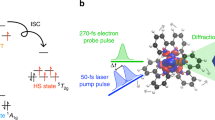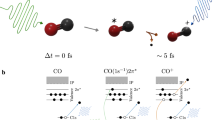Abstract
Photochemical reactions are essential to a large number of important industrial and biological processes. A method for monitoring photochemical reaction kinetics and the dynamics of molecular excitations with spatial resolution within the active molecule would allow a rigorous exploration of the pathway and mechanism of photophysical and photochemical processes. Here we demonstrate that laser-excited muon pump–probe spin spectroscopy (photo-μSR) can temporally and spatially map these processes with a spatial resolution at the single-carbon level in a molecule with a pentacene backbone. The observed time-dependent light-induced changes of an avoided level crossing resonance demonstrate that the photochemical reactivity of a specific carbon atom is modified as a result of the presence of the excited state wavefunction. This demonstrates the sensitivity and potential of this technique in probing molecular excitations and photochemistry.




Similar content being viewed by others
References
Singer, C. E. & Ames, B. N. Sunlight ultraviolet and bacterial DNA base ratios. Science 170, 822–826 (1970).
Margulis, L., Walker, J. C. G. & Rambler, M. Reassessment of roles of oxygen and ultraviolet light in Precambrian evolution. Nature 264, 620–624 (1976).
Jacobsen, E. N., Pfaltz, A. & Yamamoto, H. Comprehensive Asymmetric Catalysis (Springer, 1999).
Ojima, I. Catalytic Asymmetric Synthesis 3rd edn (Wiley, 2010).
Hoffmann, N. Photochemical reactions as key steps in organic synthesis. Chem. Rev. 108, 1052–1103 (2008).
Lévesque, F. & Seeberger, P. H. Continuous-flow synthesis of the anti-malaria drug artemisinin. Angew. Chem. Int. Ed. 51, 1706–1709 (2012).
Lunt, R. R., Giebink, N. C., Belak, A. A., Benziger, J. B. & Forrest, S. R. Exciton diffusion lengths of organic semiconductor thin films measured by spectrally resolved photoluminescence quenching. J. Appl. Phys. 105, 053711 (2009).
Menke, S. M., Luhman, W. A. & Holmes, R. J. Tailored exciton diffusion in organic photovoltaic cells for enhanced power conversion efficiency. Nat. Mater. 12, 152–157 (2013).
Hofmann, S., Rosenow, T. C., Gather, M. C., Lüssem, B. & Leo, K. Singlet exciton diffusion length in organic light-emitting diodes. Phys. Rev. B 85, 245209 (2012).
High, A. A., Novitskaya, E. E., Butov, L. V., Hanson, M. & Gossard, A. C. Control of exciton fluxes in an excitonic integrated circuit. Science 321, 229–231 (2008).
Hanna, M. C. & Nozik, A. J. Solar conversion efficiency of photovoltaic and photoelectrolysis cells with carrier multiplication absorbers. J. Appl. Phys. 100, 074510 (2006).
Ehrler, B., Wilson, M. W., Rao, A., Friend, R. H. & Greenham, N. Singlet exciton fission-sensitized infrared quantum dot solar cells. Nano Lett. 12, 1053–1057 (2012).
Congreve, D. N. et al. External quantum efficiency above 100% in a singlet-exciton-fission-based organic photovoltaic cell. Science 340, 334–337 (2013).
Uoyama, H., Goushi, K., Shizu, K., Nomura, H. & Adachi, C. Highly efficient organic light-emitting diodes from delayed fluorescence. Nature 492, 234–238 (2012).
Zhang, Q. et al. Efficient blue organic light-emitting diodes employing thermally activated delayed fluorescence. Nat. Photon. 8, 326–332 (2014).
Green, M. A., Emery, K., Hishikawa, Y., Warta, W. & Dunlop, E. D. Solar cell efficiency tables (version 46). Prog. Photovolt. 23, 1–9 (2015).
Schmidbauer, S., Hohenleutner, A. & König, B. Chemical degradation in organic light-emitting devices: mechanisms and implications for the design of new materials. Adv. Mat. 25, 2114–2129 (2013).
Kondakov, D. Y., Brown, C. T., Pawlik, T. D. & Jarikov, V. V. Chemical reactivity of aromatic hydrocarbons and operational degradation of organic light-emitting diodes. J. Appl. Phys. 107, 024507 (2010).
Yokoyama, K. et al. Future directions of μSR - laser excitation. Phys. Scr. 88, 068511 (2013).
Kadono, R., Matsushita, A., Macrae, R. M., Nishiyama, K. & Nagamine, K. Muonium centers in crystalline Si and Ge under illumination. Phys. Rev. Lett. 73, 2724–2727 (1994).
Ghandi, K., Clark, I. P., Lordc, J. S. & Cottrell, S. P. Laser-muon spin spectroscopy in liquids—A technique to study the excited state chemistry of transients. Phys. Chem. Chem. Phys. 9, 353–359 (2007).
Nuccio, L., Schulz, L. & Drew, A. J. Muon spin spectroscopy: magnetism, soft matter and the bridge between the two. J. Phys. D 47, 473001 (2014).
Fleming, D. G. et al. Kinetic isotope effects for the reactions of muonic helium and muonium with H2 . Science 331, 448–450 (2011).
Baer, S., Fleming, D., Arseneau, D., Senba, M. & Gonzalez, A. Kinetic isotope effects in gas-phase muonium reactions. ACS Symp. Ser. 502, 111–137 (1992).
Tanaka, T. & Takayanagi, T. Quantum reactive scattering calculations of H + F2 and Mu + F2 reactions on a new ab initio potential energy surface. Chem. Phys. Lett. 496, 248–253 (2010).
Claxton, T. A. Aspects of muonium chemistry. Chem. Soc. Rev. 24, 437–448 (1995).
Patterson, B. Muonium states in semiconductors. Rev. Mod. Phys. 60, 69–159 (1988).
Kreitzman, S. R. & Roduner, E. Theory of avoided level-crossing relaxation dynamics for axial muonated radicals. Chem. Phys. 192, 189–230 (1995).
Roduner, E. The Positive Muon as a Probe in Free Radical Chemistry: Potential and Limitations of the μSR Techniques (Springer, 1988).
Shimomura, K. et al. Pilot experiment for muonium photo ionization in GaAs. J. Phys. Conf. Ser. 225, 012004 (2010).
Rhodes, C. J. Muonium—the second radioisotope of hydrogen—and its contribution to free-radical chemistry. J. Chem. Soc. Perkin Trans. 2, 1379–1396 (2002).
Schulz, L. et al. Importance of intramolecular electron spin relaxation in small molecule semiconductors. Phys. Rev. B 84, 085209 (2011).
Nuccio, L. et al. Importance of spin-orbit interaction for the electron spin relaxation in organic semiconductors. Phys. Rev. Lett. 110, 216602 (2013).
Semba, M. Muon charge exchange and muonium spin exchange in gases. Hyperfine Interact. 65, 779 (1991).
Coppo, P. & Yeates, S. G. Shining light on a pentacene derivative: the role of photoinduced cycloadditions. Adv. Mater. 17, 3001–3005 (2005).
Abu-Sen, L., Morrison, J. J., Horn, A. B. & Yeates, S. G. Concentration- and solvent-dependent photochemical instability of 6,13-Bis(triisopropysilylethynyl)pentacene. Adv. Opt. Mater. 2, 636–640 (2014).
Frisch, M. J. et al. Gaussian09 Revision C.01 (Gaussian, 2010).
Murray, J. S. & Politzer, P. Statistical analysis of the molecular surface electrostatic potential: an approach to describing noncovalent interactions in condensed phases. J. Mol. Struct. 425, 107–114 (1998).
Walker, B. J., Musser, A. J., Beljonne, D. & Friend, R. H. Singlet exciton fission in solution. Nat. Chem. 5, 1019–1024 (2013).
Akselrod, G. M. et al. Visualization of exciton transport in ordered and disordered molecular solids. Nat. Commun. 5, 3646 (2014).
Lunt, R. R. et al. Exciton diffusion lengths of organic semiconductor thin films measured by spectrally resolved photoluminescence quenching. J. Appl. Phys. 105, 053711 (2009).
Acknowledgements
A.J.D. would like to acknowledge financial support from the European Research Council (MuSES project, proposal number 307593) and Sichuan University. All authors would like to acknowledge the scientific and technical support provided by the ISIS pulsed muon and neutron source. We would like to acknowledge Litron Lasers Ltd., as this work would not have been possible without their exceptional customer service and technical expertise. K.W. was funded by the Chinese Scholarship Council. P.M. was funded by Queen Mary University of London, under the Principal’s Studentship scheme.
Author information
Authors and Affiliations
Contributions
K.W. and P.M. contributed equally to this work. K.W., P.M., K.Y., J.S.L., F.L.P., J.H., L.S., M.W., N.A.M., S.Z., P.H. and A.J.D. performed the experimental work. K.Y., P.M., J.S.L. and A.J.D. designed, built, tested and commissioned the photo-μSR spectrometer (to be described fully elsewhere). P.M., K.Y., J.S.L., L.N., D.J.D., K.S., I.W., P.H. and A.J.D. set up the experimental equipment for the work reported here. K.W., J.S.L. and A.J.D. analysed and interpreted the μSR data. K.W. and A.M. performed the DFT calculations. J.E.A., P.H. and A.J.D. interpreted the implications of the results. Everyone contributed to writing the paper. A.J.D. conceived the research and managed the project.
Corresponding authors
Ethics declarations
Competing interests
The authors declare no competing financial interests.
Supplementary information
Supplementary Information
Supplementary Information (PDF 1233 kb)
Rights and permissions
About this article
Cite this article
Wang, K., Murahari, P., Yokoyama, K. et al. Temporal map** of photochemical reactions and molecular excited states with carbon specificity. Nature Mater 16, 467–473 (2017). https://doi.org/10.1038/nmat4816
Received:
Accepted:
Published:
Issue Date:
DOI: https://doi.org/10.1038/nmat4816
- Springer Nature Limited
This article is cited by
-
Easy computation of the Bayes factor to fully quantify Occam’s razor in least-squares fitting and to guide actions
Scientific Reports (2022)
-
Reply to: On the observation of photo-excitation effects in molecules using muon spin spectroscopy
Nature Materials (2022)
-
On the observation of photo-excitation effects in molecules using muon spin spectroscopy
Nature Materials (2022)
-
Regulations of silver halide nanostructure and composites on photocatalysis
Advanced Composites and Hybrid Materials (2018)





